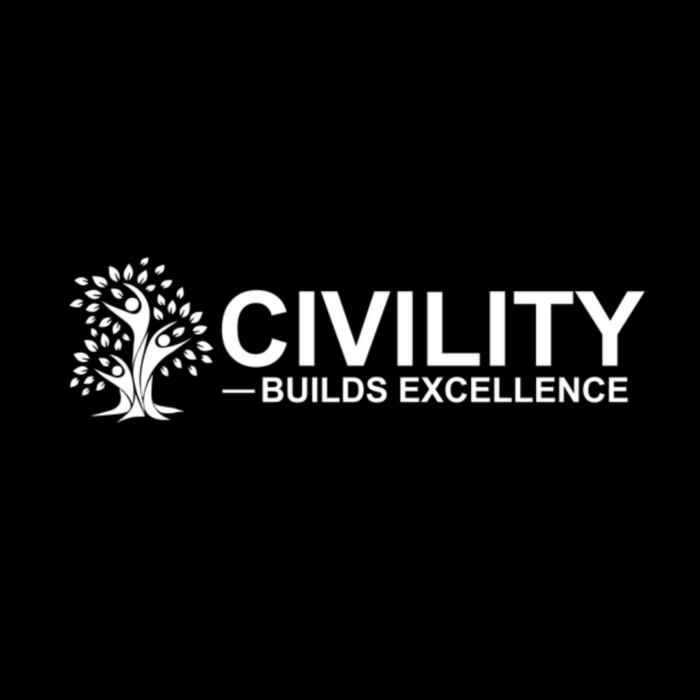
Introduction to Civility
A 30-minute discussion on civility in the workplace, brought to you by Evolution MD Martin Crump and Civility Saves Lives founder Chris Turner.
This chapter is an excerpt from our full Civility Builds Excellence course (coming soon). It’s a 30 minute discussion on civility: what it is, why it matters in the workplace, and the effects it can have on an organisation, from morale and staff retention to productivity, customer satisfaction and the bottom line.
An Introduction to Civility
This introductory session takes the form of a discussion between Martin Crump and Chris Turner on civility. Chris shares a story about how easily we can misunderstand each other, some examples of the benefits of civility, and how to create an environment where people feel able to contribute and share ideas. The session finishes off with a summary of what you’ll get out of the full Civility Builds Excellence course.
Next steps
If you enjoyed this free introductory chapter and you’d like to learn more, take a look at our longer course, Civility Builds Excellence.
The course is a great foundation and introduction to civility, and the massive impact it can have on performance, team happiness, productivity, customer experience and an organisation’s bottom line.
If you’d like to put what you’ve learned into practice in your team or workplace, we offer in-person training and coaching designed to integrate civility into your operations long-term.
Chris has years of experience delivering civility training in a healthcare setting through his initiative Civility Saves Lives with incredible results. Martin has over 30 years’ experience in corporate coaching and training, working with organisations of all shapes and sizes on leadership, strategy and communication skills.
Get in touch to enquire about civility training for your organisation, or if you’ve got any questions about this or any other course.

Civility Builds Excellence
An in-depth course on civility in the workplace, brought to you by Evolution MD Martin Crump and Civility Saves Lives founder Chris Turner.
This course explores the impact of civility in the workplace, with real-world examples and research that highlights the effect civility can have on productivity, staff retention, cost saving and reputation. We’ll look at how to put civility into practice and ways to create lasting change in your organisation.
If you’d like to explore our shorter, more focused courses, have a look at our Toolkit courses.
Course Intro: An Introduction to Civility
We kick off the course with a discussion between Martin Crump and Chris Turner on civility: what is it, and what’s the value of civility in the workplace? Chris shares a story about how easily we can misunderstand each other, some examples of the benefits of civility, and how to create an environment where people feel able to contribute and share ideas. The session finishes off with a summary of what you’ll get out of this course.
Chapter 1: Incivility
In this chapter, we look at incivility: what is it, and what are the repercussions of civility in the workplace? Chris highlights that rude or disrespectful behaviour can significantly reduce cognitive performance by up to 61%, create emotional distress, and negatively affect workplace dynamics. Incivility can be intentional, but it can also occur unintentionally, and we look at ways to avoid creating an uncivil environment, and how to instead create a respectful environment that allows individuals and teams to excel.
Chapter 2: Perception vs. Reality
Next, we’ll look at the difference between perception and reality. We examine the way our personal experiences, cultural background, cognitive filters and other factors affect the way we perceive situations: why do some people have different interpretations of the same situation? How can that understanding help us become a more compassionate, empathetic and effective leader?
We’ll look at how a good understanding of the difference between perception and reality can help us have empathy for others and so build a more civil environment.
Chapter 3: Belief Systems
In this chapter we’ll look at the belief systems loop, and how beliefs affect behaviour. When you understand the beliefs that underpin someone’s behaviour, you can more easily empathise with them, negotiate more easily and build better rapport. We look at ways to create lasting personal change by addressing beliefs at an unconscious level rather than just trying to modify surface-level behaviours.
Chapter 4: Complexity
This chapter explores the importance of civility in complex team environments. It explains how effective communication, psychological safety and respect are critical for information sharing and team performance. We look at the value of understanding different perspectives, valuing diversity, and creating an inclusive environment where team members feel comfortable contributing. Martin and Chris share examples from healthcare and organisational settings to illustrate how civility directly impacts team outcomes and decision-making.
Chapter 5: What is Your Theme Tune?
In Chapter 5 we explore communication and misunderstandings through the metaphor of a personal “theme tune” or reputation. It highlights how context, tone, and perception can lead to miscommunication, with a real-life example of workplace misunderstanding. The key lesson is that effective communication requires awareness of how our words are perceived, understanding the nuances of different communication mediums, and recognising the impact of our reputation on how others interpret our messages.
Chapter 6: Organisational Benefits
In the final chapter, we look at the organisational benefits of workplace civility, drawing from a Veterans Affairs hospitals study which showed that civility leads to increased employee satisfaction, stronger employee engagement, better staff retention, and higher trust in management. We also look at the significant cost savings for organisations as a result of civility.
Next steps
This course is a great foundation and introduction to civility, and the massive impact it can have on performance, team happiness, productivity, customer experience and an organisation’s bottom line.
If you’d like to put what you’ve learned into practice in your team or workplace, we offer in-person training and coaching designed to integrate civility into your operations long-term.
Chris has years of experience delivering civility training in a healthcare setting through his initiative Civility Saves Lives with incredible results. Martin has over 30 years’ experience in corporate coaching and training, working with organisations of all shapes and sizes on leadership, strategy and communication skills.
Get in touch to enquire about civility training for your organisation, or if you’ve got any questions about this or any other course.

The NLP Business Diploma
An in-depth course designed to help you use Neuro-Linguistic Programming skills in a business setting.
This course is for anyone who wants to get better at what they do: buying, selling, negotiating, public speaking, goal-setting, leading a team – and much more. We’ll use NLP tools and techniques to help you upskill and work towards professional goals.
If you’d like to explore our shorter, more focused courses, have a look at our Toolkit courses.
Introduction: What is NLP? A History, Background & Definition
Thanks for joining The Business NLP Diploma. This course is designed for anyone who wants to gain a more in-depth understanding of NLP, and start to use more advanced techniques, particularly in a business setting. In this chapter, we’ll introduce the concept of NLP (Neuro-Linguistic Programming), along with some history, background and a definition. We’ll look at the basic principles of NLP: what it is, how it works and how you can apply it to your day-to-day life to become a better communicator, make the most of your interactions and get better at what you do.
Conscious and Unconscious
In this session we’ll look at the difference between the conscious and unconscious mind, and how this understanding can empower you to take control of your thoughts and actions. What are some actions you carry out unconsciously? How could bringing these into your conscious mind help you?
Perception vs Reality
Next, we’ll look at the difference between perception and reality. We’ll examine the way our background and other factors affect the way we perceive situations: why do some people have different interpretations of the same situation? How can that understanding help us become a more compassionate, empathetic and effective leader?
Belief Systems Loop
In this chapter we’ll look at the belief systems loop, and how beliefs affect behaviour. When you understand the beliefs that underpin someone’s behaviour, you can more easily empathise with them, negotiate more easily and build better rapport.
Effective Communication
In this session, we’ll look at effective communication: what are the components of effective communication? What are the skills you need, and how do you do it well?
Rapport
Being able to understand your team’s drivers, challenges and needs is really important when it comes to good leadership. In this video, we’ll look at some tools for putting yourself in someone else’s shoes and how that can inform the way you work as a leader.
Representational Systems
Representational systems are the way we interpret the world and our experiences inside our head: you remember the way a memory felt, smelled, looked or sounded. When you can work out other people’s representational systems, you can find the best way to communicate them using their rep system.
Eye Accessing Cues
In this chapter, we’ll build on what we learned in the chapter on Representational Systems, and how you can use eye accessing cues to understand which Rep Systems an individual tends towards.
Presuppositions of NLP
The presuppositions of NLP are the concepts that form the core of NLP: they are a set of beliefs that allow us to understand people, empathise, and build rapport.
Goal Setting – Well Formed Outcomes
Being able to set, and more importantly, achieve your goals is essential in getting where you want to be. In this chapter I’ll give you an exercise that’s proven incredibly effective when it comes to achieving your goals on time.
Perceptual Positions
Being able to ‘put yourself in someone else’s shoes’ is an essential skill when it comes to understanding the person you’re negotiating with. This exercise will help you do that effectively, whether it’s your audience, a colleague, a friend or a business associate.
Anchoring
Next we’ll look at the NLP technique anchoring. This is a useful way to access a desirable state at any time, whether that’s feeling calm when you’re stressed, feeling confident if you’re about to give a presentation, or feeling resourceful when you need to.
Collapsing Anchors
In this chapter we’ll continue our work on anchors with a look at collapsing anchors. This is an effective way of combating a negative state – such as stress about work, or feeling nervous about speaking in front of people – and helping you to move towards a positive state.
Covert Anchoring
In our final chapter on anchoring, we look at ways to use anchoring to influence the states of others around you. This is a great way to help people you’re delivering training to be more receptive to learning, to keep someone calm while having difficult conversations at work, or to influence the buying process.
Introduction to Language Patterns
Have you ever said something to someone, only to have them completely misunderstand what you meant? In this chapter we’ll look at why that happens, and how we can use this knowledge to communicate clearly with others.
Meta Model
In this session I’ll introduce you to the Meta Model, a language pattern model designed to help you challenge non-specific language and understand what people really mean when you’re talking to them, to give you a better outcome in all your interactions.
Milton Model
Now we’re going to look at the Milton Model, another language pattern. The Milton Model provides a way to use non-specific language to allow you to be more persuasive and lead the person you’re talking to towards a desirable outcome – or just to get someone to see a different side to an argument.
Metaphors
Telling stories is one of the most powerful ways to keep your audience engaged and to speak persuasively. In this chapter we’ll look at how you can use metaphors, or stories, to their best effect.
Next steps
Now that you’ve learned about the principles and uses of NLP, you might like to try our Toolkit courses. These are short, focused courses that deliver practical tools and skills around a particular topic. Have a look at our Mentor’s Toolkit, designed for anyone in a mentor or leadership role, or our Stress Management Toolkit, which is designed to help you combat stress with useful, real-world habits.
If you’ve got any questions about the course, feel free to get in touch.

Change Management Toolkit
A toolkit course designed to help you navigate change in your organisation.
We’ll look at some useful tools for managing change, how to develop a change strategy, and how to get a buy in for your planned change from your team.
Have a look at our other Toolkit courses here.
Introduction: The Nature of Change
Change is a key part of life, and it’s certainly a key part of business. It’s a constant, and the only thing you can be certain of is that it’s going to happen. The way you deal with change is important if you’re going to make that change a success. We’ve done a lot of work looking at different ideas around change and have come up with a process that works really well. In this chapter, we’ll introduce you to that process.
Chapter 2: Developing a Change Strategy
In this chapter we’ll look at developing a strategy for change, and what you need to consider when implementing change in an organisation. What’s the impact the change is going to have on your organisation? What’s the purpose of the change and what are you hoping to achieve? We’ll answer these questions, along with lots more, in this session.
Chapter 3: Getting a Buy-In to Your Change
Once you’ve got a strategy in place, you need to sell this change to your team and get them to buy in. If they’re bought in, implementing this change will be easy – if they’re not, you’ll struggle and you likely won’t achieve everything you’re hoping to. In this chapter we’ll look at ensuring your team is on board, and your change is a success.
Here are some useful sessions on effective communication that will help you get your organisation on-side.
Next steps
Now that you’ve learned effective ways to manage change, why not try another of our Toolkit courses?
For more support dealing with change on a business and personal level, have a look at our Evolve or Die course. It’ll walk you through the process of taking your life or business to the next level and give you useful exercises and a fail-safe timeline for achieving your goals.

Welcome to the Managing Difficult Conversations Course
A short, focused course designed to help you become an expert at managing difficult conversions.
From time to time everyone will face conversations which they anticipate will be difficult and which they may feel ill-equipped to handle. This course is designed to give you the tools to navigate these conversations with ease, with great outcomes for both parties.
If you’d like to get better at staying calm and managing stress, try our Stress Management Toolkit.
Download the Course Manual
Before you get started, download the course manual here. You can print it out, and make your own notes on the pages, or download as a PDF.
Download the course manualIntroduction
Thanks for joining me on this Managing Difficult Conversations course. We all have to have difficult conversations at some point in our personal and working lives, and being confident in doing so will enable you to handle them effectively, and create a better eventual outcome. In this introduction we’ll look at why it’s important to get comfortable having difficult conversations, and outline the process we’ll be using.
Building Rapport
Good communication starts with building rapport. In this session, we’ll look at what rapport is, why it’s so important, and how you can build it with anyone.
Active Listening
How do you get the most out of a difficult conversation? Active listening. Whether you’re the on the giving or the receiving end, being an active listener will help you get through a difficult conversation without conflict – and with a good outcome at the end.
Questioning & Question Types
Understanding the value of asking questions is essential in all types of interactions, but especially when having a difficult conversation. In this chapter we’ll look at the different types of questions, and how you can use them to get the best results.
Putting Yourself in their Shoes (Perceptual Positions)
When you’re having a difficult conversation with someone, it can be really helpful to put yourself in their shoes, to understand how they’re thinking and feeling so that you can approach the conversation with empathy and understand their point of view. This exercise helps you get into that mindset, as well as providing a framework you can use to help the person you’re having the conversation with understand your or others’ point of view.
Assertiveness
It’s important to approach a difficult conversation with confidence, with respect for yourself and others – that’s assertiveness. In this chapter we’ll look at how to be assertive (and what assertiveness isn’t).
Structured Feedback
Generally speaking people don’t know if they are doing well or doing badly if you don’t tell them – that’s why feedback is so important. Giving feedback in a structured way, thinking through how the receiver might react and how you’ll respond to that, can go a long way to ensuring your conversation is positive and productive for everyone involved.
Goal Setting
A clear process for goal setting will give your conversation a path for a good outcome: it’s a really useful skill to have, and this particular process is an almost failsafe method for ensuring that you achieve the goals you set.
Delegation
Delegation is a useful tool for resolving all kinds of work-related issues (stress, feeling overwhelmed, low productivity etc), so knowing how to delegate effectively is an essential skill. In this chapter we’ll look at the process of delegation with an example of an effective delegation plan.
Next steps
Now that you’ve learned how to manage difficult conversations really well, you might like to look at our other Toolkit courses: try our Mentor’s Toolkit or our Stress Management Toolkit.
If you’d like to go more in-depth and learn to change your behaviour to get the most out of your life, or work towards big personal or professional goals, have a look at the NLP Business Practitioner course. The Business Practitioner is a group course that runs over 10 two-hour sessions, and will help you understand the way you and others think and behave, so you can get the most out of every interaction.

Welcome to the Mentor’s Toolkit
A short, focused course designed to help you become a great mentor.
What does it mean to be a good mentor? In this`Toolkit course, we’ll answer that question, and give you a solid framework for becoming a really good mentor, along with some essential mentoring skills.
If you enjoy this course and would like to learn more on a related topic, try our Professional Coach Course.
Introduction
Thanks for joining me on The Mentor’s Toolkit. In the introduction we’ll look at what being a mentor really means, the difference between being a coach, counsellor and mentor, and some processes to help you become a more effective mentor.
Active Listening
In this chapter, we’ll look at the difference between active and passive listening, and how you can use active listening to help you become a supportive mentor.
Question Types
One of the best ways of getting information from people is asking questions. In this chapter, we’ll learn how to use questions effectively, in the right situations, to help the person you’re mentoring.
Goal Setting
As a mentor, you’ll often be required to help the person you’re mentoring set and achieve goals. In this session, we’ll look at some useful processes for goal setting.
Building Rapport
Establishing a good connection between yourself and the person you’re mentoring will help you – and them – get the most out of the work you do together. That’s where rapport comes in: in this session, we’ll look at the importance of rapport and how to build it effectively.
Giving and Receiving Feedback
Lots of people find giving feedback difficult, and often we tend to give more negative feedback than positive. In this chapter, we’ll look at how to deliver feedback in a structured way.
Using Metaphor
Telling stories is a really effective way to get your point across, or to lead someone you’re mentoring to a conclusion without being too direct. In this chapter we’ll look at using metaphor, or story-telling, to make you a more effective mentor.
Next steps
Now that you’ve learned how to become a great mentor, you might like to try our Professional Coach Course.
If you’d like to go more in-depth and learn to change your behaviour to get the most out of your life, or work towards big personal or professional goals, have a look at the NLP Business Practitioner course. The Business Practitioner is a group course that runs over 10 two-hour sessions, and will help you understand the way you and others think and behave, so you can get the most out of every interaction.

NLP Business Practitioner Course
An in-depth course designed for anyone who’d like to get better at what they do, and work towards personal or professional goals.
This course is for anyone who’d like to develop their leadership, motivation, goal setting, selling, buying, presenting, performance management, confidence, stress management or communication skills – to name a few.
Planning a career change? If you’d like to learn how to become a coach, try our How to Become a Professional Coach course.
Useful Tools Before You Start
In this chapter I’ll provide you with some useful tools to help you as you complete the NLP Business Practitioner course.
Click here to download the course manual, with notes on each of the course chapters and exercises for you to complete.
Download the Business Practitioner Course ManualHere you can download the Learning Log. Use this to record your learning throughout the course: which NLP techniques you’ve put into practice and how you found the process.
Download the Learning LogThe ANKI App is a really useful tool for learning course information; use it to create flashcards and test yourself. Here’s how it works.
What is NLP?
In this first chapter, we’ll look at the background of NLP: what it is, how it works, and how you can use it to help you become a better communicator and get better at what you do.
Perception and Reality
Conscious and Unconscious
In this session we’ll look at the difference between the conscious and unconscious mind, and how this understanding can empower you to take control of your thoughts and actions. What are some actions you carry out unconsciously? How could bringing these into your conscious mind help you?
Next, we’ll look at the difference between perception and reality. We’ll examine the way our background and other factors affect the way we perceive situations: why do some people have different interpretations of the same situation? How can that understanding help us become a more compassionate, empathetic and effective leader?
Understanding Perception and Reality
Belief Systems
In this chapter we’ll look at the belief systems loop, and how beliefs affect behaviour. When you understand the beliefs that underpin someone’s behaviour, you can more easily empathise with them, negotiate more easily and build better rapport.
Effective Communication
In this session, we’ll look at effective communication, and how to do it well.
Key Processes
Now we’re going to look at some of the key processes that are fundamental to NLP that are essential to communicating and influencing well; including pacing and leading and rapport.
Rapport
Being able to understand your team’s drivers, challenges and needs is really important when it comes to good leadership. In this video, we’ll look at some tools for putting yourself in someone else’s shoes and how that can inform the way you work as a leader.
Representational Systems
Representational systems are the way we interpret the world and our experiences inside our head: you remember the way a memory felt, smelled, looked or sounded. When you can work out other people’s representational systems, you can find the best way to communicate them using their rep system.
Eye Accessing Cues
In this chapter, we’ll build on what we learned in the chapter on Representational Systems, and how you can use eye accessing cues to understand which Rep Systems an individual tends towards.
The Presuppositions of NLP
The presuppositions of NLP are the concepts that form the core of NLP: they are a set of beliefs that allow us to understand people, empathise, and build rapport.
Goal Setting: Well-Formed Outcomes
Being able to set, and more importantly, achieve your goals is essential in getting where you want to be. In this chapter I’ll give you an exercise that’s proven incredibly effective when it comes to achieving your goals on time.
Perceptual Positions
Being able to ‘put yourself in someone else’s shoes’ is an essential skill when it comes to understanding the person you’re negotiating with. This exercise will help you do that effectively, whether it’s your audience, a colleague, a friend or a business associate.
Anchoring
Next we’ll look at the NLP technique anchoring. This is a useful way to access a desirable state at any time, whether that’s feeling calm when you’re stressed, feeling confident if you’re about to give a presentation, or feeling resourceful when you need to.
Submodalities
In this chapter, we’ll expand on what we learned about representational systems, and how we can use submodalities to change attitudes to various activities and processes.
Introduction to Language Patterns
Have you ever said something to someone, only to have them completely misunderstand what you meant? In this chapter we’ll look at why that happens, and how we can use this knowledge to communicate clearly with others.
The Meta Model
In this session I’ll introduce you to the Meta Model, a language pattern model designed to help you challenge non-specific language and understand what people really mean when you’re talking to them, to give you a better outcome in all your interactions.
The Milton Model
Now we’re going to look at the Milton Model, another language pattern. The Milton Model provides a way to use non-specific language to allow you to be more persuasive and lead the person you’re talking to towards a desirable outcome – or just to get someone to see a different side to an argument.
Metaphors
Telling stories is one of the most powerful ways to keep your audience engaged and to speak persuasively. In this chapter we’ll look at how you can use metaphors, or stories, to their best effect.
Chunking
In this session we’ll look at chunking. You can either chunk up, into bigger ideas or more abstract concepts, or chunk down into detail. You can use this technique to influence people’s choices – here’s how.
Strategies
In NLP, we model the processes successful people use to achieve the things they want. In this session, we’ll look at how that process works, and how you can model the behaviour of people who are successful at what you’re trying to achieve. It’s also a great way of influencing someone’s buying process.
Next steps
Now that you’ve completed the NLP Business Practitioner course, you might like to move on to the NLP Master Practitioner course. The Master Practitioner course is designed to develop the concepts and techniques you learned in this course further: you’ll learn how to put these ideas into practice and how to get real results from the things you’ve learned. The Master Practitioner course is where lots of our delegates see real change happen in their lives; if you’ve got big plans or goals (career or personal), this course will help you get there.
You can also have a look at our shorter, more targeted courses on topics like Time Management, Stress Management or Having Difficult Conversations.

How to Become a Professional Coach
An in-depth course designed for anyone looking to become a successful professional coach.
If you’ve ever wanted to either be a professional coach, or utilise really strong coaching skills in your leadership role – this is the one for you. This will take you through a comprehensive list of NLP-based skills, thought processes and models to help you excel as a coach.
If you’d like to improve your leadership skills, either as a coach or in your own job role, try our Leading Teams in a Flexible Working Environment course.
Introduction
Thanks for joining me on my Professional Coach Course. In this video we’ll start by looking at exactly what a coach is, and what a coach does: how you can facilitate lasting change in your coaching clients and help them achieve their goals.
Here you can download the course manual: you can either keep it as a PDF to read on your computer or tablet, or print it out.
Download the course manualSome Core Beliefs and Concepts
In this chapter we’ll start by looking at some of the core concepts of NLP, and how you can use them to become an effective and successful coach.
The Presuppositions of NLP
Values
Roger’s Core Conditions
The First Session
In this chapter you can download some useful examples of the documentation you’ll need to get started: a sample Coaching Contract and a sample Intake Questionnaire.
Download the sample Coaching Contract Download the sample Intake QuestionnaireCore Coaching Skills
In this chapter we’ll look at some of the essential skills required for working as a coach: building rapport, active listening and asking constructive questions.
Rapport
Active Listening
Question Types
Challenging – The Meta Model
Some Really Useful Tools
In this chapter, we’ll cover some really useful tools to have in your coaching toolbox. These are exercises you can use with coaching clients to help them set goals (and achieve them), uncover and unpick habits that aren’t serving them, or access a particular state (like feeling calm and confident).
Goal Setting and Well-Formed Outcomes
Strategies
What is Anchoring?
Setting an Anchor
Metaphors
Perceptual Positions
The GROW Model
Coaches’ Responsibilities
Being a coach is a really important and fulfilling job – and that means that there are certain responsibilities that come along with the role. In this chapter we’ll break down those responsibilities and how you can make sure you’re fulfilling them.
Next steps
Now that you’ve learned the essentials to becoming a professional coach, you might like to join one of our more involved courses, like the NLP Business Practitioner (or the Personal Transformation course, if you’ve already completed the Personal Growth or Business Practitioner course). The Business Practitioner or Personal Growth courses are designed to help you achieve the life you want: you’ll set goals (professional or personal) and learn how to achieve them, learn new techniques that really work for communicating and interacting with others, among lots of other useful tools.
If you would like to try a shorter, more focused course, have a look at our Stress Management Toolkit, Resilience Toolkit and Time Management Toolkit.

How to Lead a Team in a Flexible Working Environment Leading in a hybrid or traditional working environment
An in-depth course designed for anyone in a leadership role, especially if you’re managing a remote-working or flexibly working team.
The purpose of this course is to help you become a better leader – whether that’s a leader of a remote team or a face-to-face team. You’ll learn the difference between leading and managing and fill your leadership toolbox up with practical tools you can put to work straight away.
If you’d like to get better at staying calm and managing stress, try our Stress Management Toolkit.
Introduction – Why Leadership? Why Flexible Working?
An introduction to this leadership course. We’ll be focusing on leading teams in a flexible working/hybrid working/remote working environment, but the course is suitable for anyone in a leadership role.
Before we get started, download and fill in this Leadership Questionnaire, designed to help you understand your leadership style.
Download the Leadership QuestionnaireWhat is Leadership?
In this session we’ll look at some examples of great leadership, what makes them good leaders, and how you can model those behaviours yourself to get the same results.
Some Leadership Theories
In this chapter we’ll look at some leadership theories, such as situational leadership and action-centred leadership, and how you can use these ideas to become a better, more effective leader.
Do you know the difference between management and leadership? We’ll compare ‘management behaviour’ and ‘leadership behaviour’, and how understanding the distinction can help you manage your team.
Leading Remotely
One of the things the pandemic taught us was that it is possible to lead a team effectively while working remotely. In this chapter, we’ll look at the difference between leading face-to-face and leading remotely, and some top tips for anyone leading a remote team.
Transformation and Outcomes-Based Leadership
In this session, we’ll look at goal-setting and a helpful process for setting goals and achieving them.
In this video, we’re exploring transactional vs transformational leadership. We’ll look at some of the assumptions commonly made about leadership, and how to lead in a transformational way.
Developing an Effective Team
How would you define an effective team? What makes a team? In this chapter, we’ll look at what you can do to develop an effective team that’s productive, happy and easier to lead.
In this video, we’ll look at team roles (including Belbin roles), and how to balance a team in the most effective way.
Motivating Individual Team Members
Being able to understand your team’s drivers, challenges and needs is really important when it comes to good leadership. In this video, we’ll look at some tools for putting yourself in someone else’s shoes and how that can inform the way you work as a leader.
Next we’re going to look at the way our background and other factors affect the way we perceive situations: why do some people have different interpretations of the same situation? How can that understanding help us become a more compassionate, empathetic and effective leader?
In this video, we’ll explore the idea that people are essentially motivated in two ways: either towards (goal-focused), or away from. We’ll look at how you can use this concept to motivate your team.
In this session we’ll look at another motivation theory: McGregor’s Theory X and Theory Y. Before starting the video, download and fill out the ‘Assumptions About People at Work’ questionnaire.
Next, we’ll look at another motivation theory: Herzberg’s Theory of Motivation. Before you get started, download and fill in the questionnaire on Motivation Factors.
Structured Feedback
Learning to give feedback effectively is an essential part of being a good leader. In this video, we’ll look at feedback, why it’s important, and the benefits.
In this video, I’ll show you something really useful: how to give negative feedback in a non-judgmental, structured way.
Delegation
In this chapter, we’ll look at delegation. What is it, how to decide who to delegate to, how to effectively delegate and a useful exercise for practicing this skill.
Effective Communication
In the final session of this course, we’re going to look at effective communication, and how to do it well.
Next steps
Now that you’ve learned how to become an effective leader, whether that’s face-to-face or remotely, you might like to try one of our Toolkit courses. The Toolkit courses are short, focused courses on topics like Presenting & Public Speaking, Stress Management, and Prioritising Your Workload.
If you’d like to go more in-depth and learn to change your behaviour to get the most out of your life, or work towards big personal or professional goals, have a look at the NLP Business Practitioner course. The Business Practitioner is a group course that runs over 10 two-hour sessions, and will help you understand the way you and others think and behave, so you can get the most out of every interaction.

How to Give and Receive Feedback
A 10-minute focused microlearning course designed to help you give and receive feedback effectively and constructively.
Feedback is crucial to helping people and relationships develop. In this microlearning course you’ll learn how to give and receive feedback in a non-judgemental, objective way (possibly the most important thing you will learn).
Have a look at our other Microlearning courses here.
Giving and Receiving Feedback
Got 10 minutes? This microlearning course is designed to fit into your down-time. It’s designed to give you practical methods for delivering and receiving feedback in a way that ensures both sides come out of the discussion happy: essential for workplace conversations and really useful for personal conversations too.
Next steps
Now that you’ve learned how to give and receive feedback effectively, why not try another of our microlearning courses?
If you’d like to get better at what you do, have a look at our NLP Business Practitioner course. It’s designed to give you presenting, goal-setting, selling, negotiating and communication skills that you can put into practice in any career. Many of our delegates find that the course has a positive effect in their personal lives too, and that after completing the course they’ve made real steps towards achieving the lifestyle they really want to live.

How to Prioritise Your Workload
A 10-minute focused microlearning course designed to help you prioritise your workload.
This short microlearning course will give you a real time, visual prioritisation tool based on the Eisenhower matrix. It’ll help you work out what’s important, what’s urgent, how to tell the difference and how to put that into practice so you’ve got an organised, prioritised to-do list.
Have a look at our other Microlearning courses here.
Prioritising Your Time With the Evolution Task Manager
Got 10 minutes? This microlearning course is designed to fit into your down-time. We’ll look at a useful exercise for prioritising your workload, and you’ll finish the 10-minute video with a plan you can put into action right away.
Next steps
Now that you’ve learned how to prioritise your workload, why not try another of our microlearning courses?
If you’re starting a new venture like a podcast or coaching business, have a look at our Evolve or Die course, which will walk you through the planning process and give you useful exercises and a fail-safe timeline for achieving your goals.

How to Edit Sound for Video and Podcast
A 10-minute focused microlearning course designed to help you edit sound for video and podcast.
In this short microlearning course, I’ll show you how to use Audacity to edit recorded audio for use in video or podcasts.
Have a look at our other microlearning courses here.
Using Audacity
If you create videos, audio recording or podcasts, knowing how to edit your audio so that it sounds clear and professional is essential. Perhaps you’re thinking about starting a business, beginning a podcast or becoming a coach: video and audio recordings can be a useful tool for lots of professions and in this video I’ll show you how to ensure your audio sounds great.
Next steps
Now that you’ve learned how to edit great audio, why not try another of our microlearning courses? [LINK]
If you’re starting a new venture like a podcast or coaching business, have a look at our Evolve or Die course [LINK], which will walk you through the planning process and give you useful exercises and a fail-safe timeline for achieving your goals.
